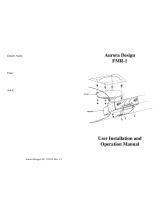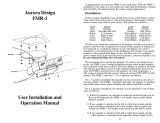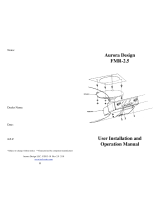Page is loading ...

Note: seek-button refers to the Wonderbar or Town & Country button on a
signal seeking radio. In AM/FM mode this button will only control the
radio seek function, not the Bluetooth/USB.
Bluetooth® is a registered trademark of the Bluetooth SIG
AAC trademark used under license from Via Licensing
All other trademarks are those of their respective owners
Aurora Design LLC. ©2014-16 Rev 2.2 9/16
Aurora Design
BT-2
Bluetooth/AAC Adapter
User Operation
Manual
!!

Under Industry Canada regulations, this radio transmitter may only
operate using an antenna of a type and maximum (or lesser) gain approved
for the transmitter by Industry Canada. To reduce potential radio
interference to other users, the antenna type and its gain should be so
chosen that the equivalent isotropically radiated power (e.i.r.p.) is not
more than that necessary for successful communication.
Le présent appareil est conforme aux CNR d'Industrie Canada applicables
aux appareils radio exempts de licence. L'exploitation est autorisée aux deux
conditions suivantes: (1) l'appareil ne doit pas produire de brouillage, et (2)
l'utilisateur de l'appareil doit accepter tout brouillage radioélectrique subi,
même si le brouillage est susceptible d'en compromettre le fonctionnement.
Conformément à la réglementation d'Industrie Canada, le présent émetteur
radio peut fonctionner avec une antenne d'un type et d'un gain maximal (ou
inférieur) approuvé pour l'émetteur par Industrie Canada. Dans le but de
réduire les risques de brouillage radioélectrique à l'intention des autres
utilisateurs, il faut choisir le type d'antenne et son gain de sorte que la
puissance isotrope rayonnée équivalente (p.i.r.e.) ne dépasse pas l'intensité
nécessaire à l'établissement d'une communication satisfaisante.
Specifications:
Bluetooth Transceiver*:
Frequency Band:! 2.40-2.48GHz
Standard:! Bluetooth 4.1, Class 2
Profiles:! HFP 1.6, A2DP 1.2, AVRCP 1.5
Sensitivity:! -90dBm @ 0.1% BER
TX Power:! 4dBm maximum
Environmental:
Temperature:! -30C to 65C (-22F to 150F) Operating
! -40C to 125C (-40F to 257F) Storage
Humidity:! 10% to 90% non-condensing
Aurora Design LLC. does not assume any responsibility for personal
injury or property damage incurred due to hazardous driving as a result of
interaction with the BT-2 or other Bluetooth devices.
BE SAFE! Never text while driving or be distracted by the radio.
*Characterized by component manufacturer
Bluetooth® is a registered trademark of the Bluetooth SIG
AAC trademark used under license from Via Licensing
Aurora Design LLC. ©2014-16 Rev 2.0 5/16
!! 6

Troubleshooting:
Poor Range: Make sure nothing is obstructing the dial face of the radio,
or the openings along the bottom side of the radio chassis. Try moving
your Bluetooth device to a different location.
No Sound: Make sure the BT-2 is paired and connected to your device.
Also make sure the BT-2 is selected as the audio device for streaming
audio and hands-free operation on your device following the
manufacturers instructions. Verify the audio levels are set properly on
the Bluetooth device.
US Certification:
FCC ID: A8TBM20SPKXYNBZ
This equipment has been tested and found to comply with the limits for
a Class B digital device, pursuant to part 15 of the FCC Rules. These
limits are designed to provide reasonable protection against harmful
interference in a residential installation. This equipment generates, uses
and can radiate radio frequency energy, and if not installed and used in
accordance with the instructions, may cause harmful interference to
radio communications. However, there is no guarantee that interference
will not occur in a particular installation. If this equipment does cause
harmful interference to radio or television reception, which can be
determined by turning the equipment off and on, the user is encouraged
to try to correct the interference by one or more of the following
measures:
•
Reorient or relocate the receiving antenna.
•
Increase the separation between the equipment and receiver.
•
Consult the dealer or an experienced radio/TV technician for help.
European Certification:
The Bluetooth module used in this device complies with the essential
requirements of the R&TTE 1999/EC, the EMC Directive 2004/108/EC
and the low-voltage Directive 2006/95/EC.
Canadian Certification:
IC: 12246A-BM20SPKS1
This device complies with Industry Canada license-exempt RS
standard(s). Operation is subject to the following two conditions: (1) this
device may not cause interference, and (2) this device must accept any
interference, including interference that may cause undesired operation
of the device.
Congratulations on your new Aurora Design BT-2 Bluetooth/AAC
adapter. Combined with an FMR-2 converted radio, you can enjoy 21
st
century technology in your classic vehicle!
Setup: Your radio may have come equipped with an internal
microphone. If not, before installing your radio back into your vehicle,
you may wish to plug the hands-free microphone or optional illuminated
pushbutton into the appropriate jacks on the radio. The microphone can be
placed in a convenient location in the vehicle, typically along the front
edge of the headliner near the rear view mirror or along the bottom edge of
the dashboard. The attached cable is 9.8’ (3M) long and can be routed as
required, typically behind the A pillar cover for headliner mounting.
Excess cable can be coiled and tied off.
The optional pushbutton assembly is not required when used with an
FMR-2 converted radio as the existing radio controls can be used to fully
control the BT-2. The pushbutton assembly can still be used with an
FMR-2 converted radio if desired, and must be used with all other
installations. The pushbutton requires a 1/2” (12.7mm) hole and should be
mounted somewhere convenient such as the bottom edge of the dashboard.
The pushbutton is illuminated with a red status LED that should be made
visible for easiest operation. The attached cable is 3.3’ (1M) long and can
be routed as required. Excess cable can be coiled and tied off.
Basic Operation: Operation of the BT-2 is extremely simple yet
powerful. The BT-2, when combined with an FMR-2 AM/FM receiver
form a fully integrated AM/FM/Bluetooth/AAC solution. Communication
over a proprietary com-link keeps the two modules in perfect sync. No
external cables, plugs or switches are required. Full operation is provided
by the existing controls on the radio. When streaming music or handling a
phone call, the FMR-2 status LED will change color to indicate Bluetooth
operation. (see FMR-2 manual for more information on status LED) When
you stop streaming music or end a call, the BT-2 will put the FMR-2 back
into normal operation. Everything is handled automatically.
The BT-2 supports SBC and AAC formats over Bluetooth. AAC files
offer higher quality and is the native format used by iTunes® and many
other popular music services. ACC files will play natively off compatible
Bluetooth devices.
The BT-2 will always return to the last mode it was in when the radio
was turned off assuming the Bluetooth device is still present. For example,
if the BT-2 was playing back from the Bluetooth when the radio was
powered off, it will return to playing back from where it left off when the
radio is turned back on.
The BT-2 supports Voice Assist which will speak messages to you in
English, Spanish or French to assist in the operation of the radio.
Bluetooth Pairing: To pair a new device, twist the volume control
back and forth twice towards the direction of higher volume. (this is the
!5! 2

same action that is used with the tone control to access the virtual fader
function) or push and hold the optional pushbutton. The optional front
panel status LED or the optional pushbutton LED will flash and a Voice
Assist message will be heard in the radio. The BT-2 will then go into
pairing mode for approximately 90 seconds or until a device is paired.
While in pairing, the BT-2 will display as AuroraDesign BT-x.x in the
Bluetooth section of your device. (x.x represents the version) Select the
BT-2 to connect. (refer to the owners manual for your Bluetooth device for
information on pairing) If you wait longer than 90 seconds the BT-2 will
time out and Voice Assist message will be heard. Up to eight devices can
be paired to the BT-2.
Bluetooth Connecting: The BT-2 will automatically attempt to
reconnect to the last connected Bluetooth device. If this device is not
within range, the BT-2 will then attempt to reconnect to any of the last four
connected devices. This is handy when the user has multiple Bluetooth
devices, or several people use the radio. If any paired device is within
range when the radio is powered on, the BT-2 will reconnect and return to
its last mode. The optional front panel LED or the optional pushbutton
LED will illuminate to signify a Bluetooth device is connected. A Voice
Assist message will also be heard in the radio when a Bluetooth device
successfully connects.
Bluetooth Audio Levels: The BT-2 sends commands to the
connected Bluetooth device to adjust the playback audio levels, but many
devices require that the user make these settings manually. Usually the
playback levels for audio streaming, phone calls and Voice Command are
all stored separately so must be adjusted separately. The first time you
stream audio, take a phone call, or use the Voice Command feature, use the
volume buttons or volume slider menu on the device to adjust the audio
level. This only needs to be performed once on the device as these settings
are permanently saved in the device.
Bluetooth Voice Command: The Bluetooth Voice Command feature
allows the user to control their compatible Bluetooth device through voice
commands. The Voice Command feature is accessible in all radio modes. It
is designed to work with Apple Siri
®
, Google Voice
®
and Microsoft
Cortana
®
and other Bluetooth voice interfaces. To initiate a Voice
Command, twist the volume control back and forth twice towards the
direction of higher volume or push and hold the optional pushbutton/seek-
button. (this is the same motion that was used to open up pairing) Wait for
the confirmation tone from the Bluetooth device and then speak the
command. For example you can say things like “call home” or “play
Bruce Springsteen”. Check with the manual for your Bluetooth device for
further information on its support for voice commands.
Bluetooth Streaming: To start playing music from the Bluetooth
interface, twist the volume control back and forth twice towards the
direction of lower volume or push and hold the optional pushbutton/seek-
button for about 1 second. (you can also use the menus on your Bluetooth
device to control the audio) To toggle between pause and play, repeat the
procedure above. When the audio is paused, the FMR-2 status LED will
blink slowly. If the audio is paused for more than about 10 seconds, the BT-2
will release the FMR-2 and it will switch back to normal radio operation. If
playback is started again, it will continue from where it left off.
To skip to the next song, twist the tuning control towards the high
frequency end of the dial or quickly press the optional pushbutton/seek-
button once. To skip to the previous song, twist the tuning control towards
the low frequency end of the dial or quickly press the optional pushbutton/
seek-button twice. (Hint: when twisting the tuning control, twist it in the
desired direction and then back to the starting point. This way the tuner
always remains in the same position)
Hands-free Phone: When a phone call comes in, the FMR-2 will
mute the radio and ring through. To accept the call, twist the tuning control
towards the high frequency end of the dial or quickly press the optional
pushbutton/seek-button once. To reject or end a call, twist the tuning
control towards the low frequency end of the dial or quickly press the
optional pushbutton/seek-button twice or press the seek button again.
To mute the microphone, twist the volume control back and forth
twice towards the direction of lower volume or push and hold the optional
pushbutton/seek-button for about 1 second. (you can also use the menus
on your Bluetooth device to control the audio) A repeating confirmation
tone will be heard on the radio while the call is muted. To toggle between
mute and unmuted, repeat the instructions above. When the audio is
muted, the FMR-2 status LED will blink slowly. A Voice Assist message
will be heard confirming when the call ends.
For call-waiting, follow the same procedure as above to accept or
reject the waiting call. To switch between calls, use the accept call action.
To end the active call, use the reject call action. To join the calls, twist the
volume control back and forth twice towards the direction of higher
volume or push and hold the optional pushbutton/seek-button.
Note: The Bluetooth device can also be controlled using its own menus.
(follow manufactures instructions on controlling your device)
Voice Assist Language: The BT-2 can speak to you in English,
Spanish, French and simple beep tones. To select the desired language
make sure no Bluetooth device is connected to the BT-2. Now enable
Pairing as described above. After you hear the Voice Assist message, enter
Pairing again. The next language set will be heard. Continue entering
Pairing until the desired language is selected. All Voice Assist messages
will now be in the selected language.
!3! 4
/








